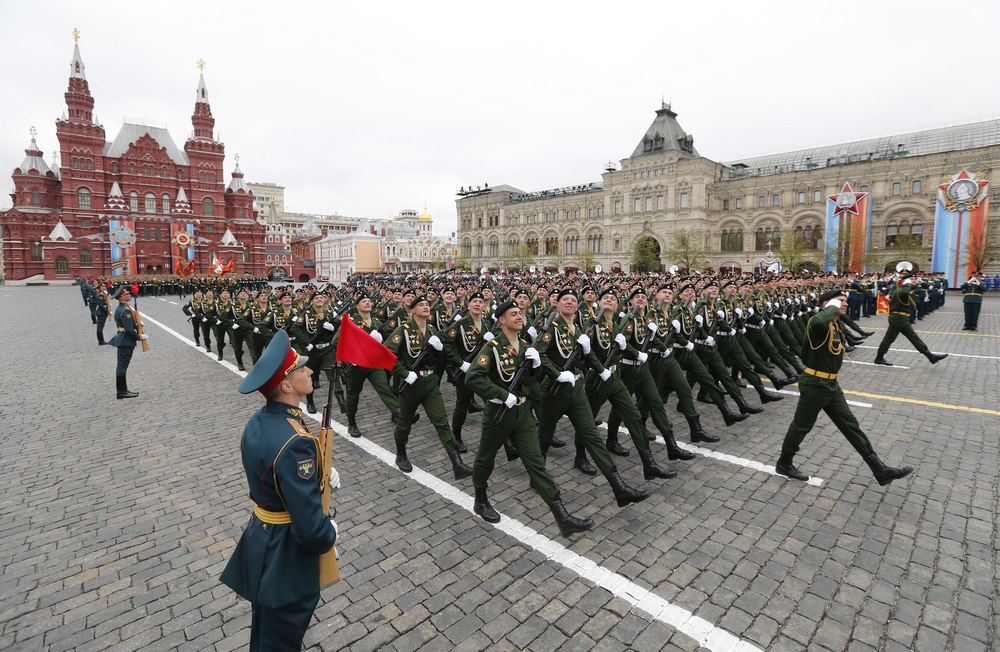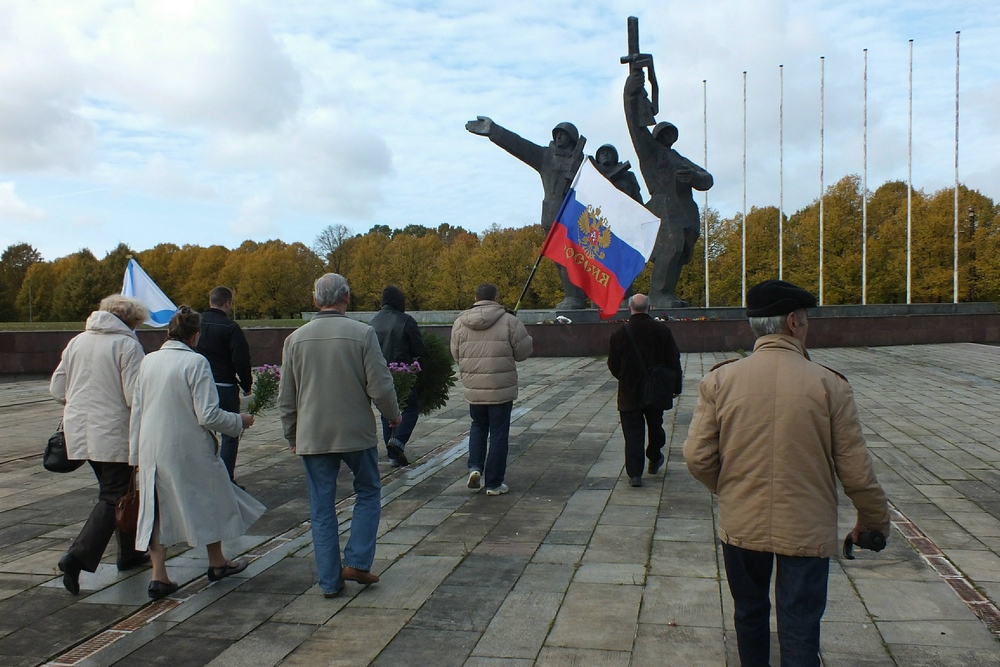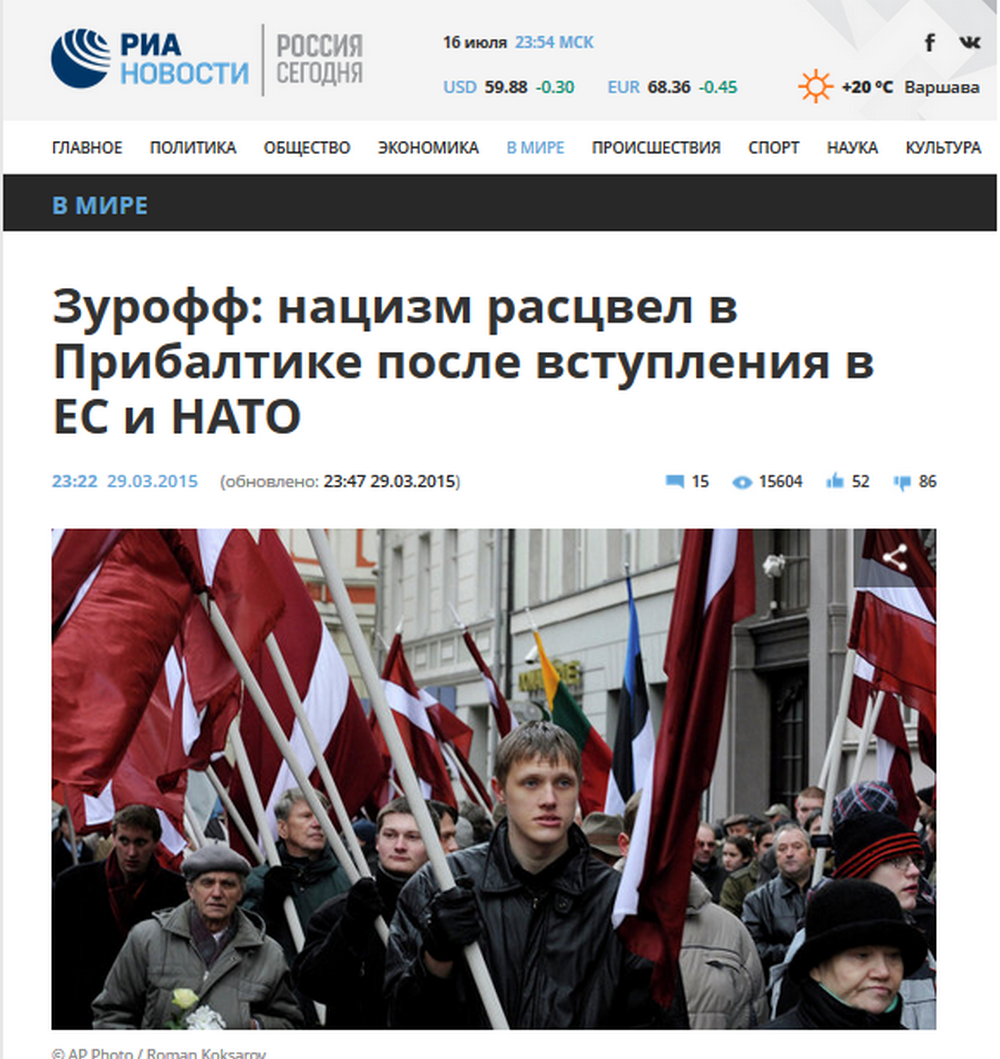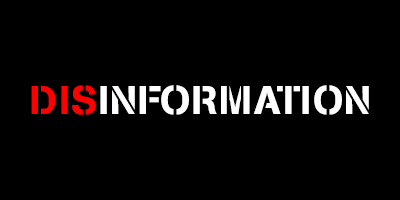THE WARSAW INSTITUTE REVIEW
Date: 20 July 2017 Author: Aleksander Król
Russian Information Warfare in the Baltic States — Resources and Aims
A resurgence of fascism, rampant Russophobia, the ethnic cleansing of local Russian populations, drunk NATO soldiers – this is how Russia portrays and slanders the societies of the Baltic States. The Russian offensive in the information sphere isn’t just a stream of buzzwords, invented by sensationalist journalists and bored political scientists. It is a strategically planned onslaught of disinformation and propaganda designed to manipulate public opinion. In the long run, its aim is to capture the hearts and minds of the Baltic peoples.

The Kremlin’s aggressive rhetoric directed toward the Baltic states is not a new phenomenon. TV programs, websites and magazines, the channels of Russian disinformation, have been overtaken the Baltic media market. The outbreak of conflict in Ukraine in 2014 was a decisive moment: western analysts became aware of the security deficiencies in the Baltic states region, particularly the threats directed at the information sphere. In addition to the aggressive narratives circulating there, the Russian Federation’s activities included intelligence activities and military provocations.[1]
Since that conflict began, we’ve witnessed Russia’s transition into an aggressive, comprehensive policy in the information sphere, coordinated by state institutions and financed through their budgets, often filtered through the medium of allegedly non-governmental organizations and foundations. Their activity consists of disseminating lies in the form of propaganda and disinformation on internal political issues, the economy and the security of the Baltic States. There were also cases of cyber-attacks to which local media outlets fell victim.
National Minorities in the Crosshairs
Russian information operations in the Baltic States are directed mainly at Russian-speaking minority communities. These communities consist of not only residents of the region, who identify as ethnic Russians, but also other minorities – Ukrainians, Belarussians, Poles – who speak Russian in everyday life. For the Kremlin, this is the core group of recipients for the messages of the information war and a tool for influencing public opinion in Lithuania, Latvia and Estonia.
Russian–speaking minorities constitute a significant proportion of the populations of Latvia and Estonia, and to a lesser extent, Lithuania. The largest percentage of this minority is in Latvia, where about 35% of the population are Russophones. The situation is shaping up similarly in Estonia where 29% of the population can be counted as part of the Russian-language community. These groups usually live in cities where industry was well-developed during the Soviet occupation. In Latvia, the main centers inhabited by the Russian-speaking population are Riga (about 50% of the population) and the eastern part of the country (Latgale) with the largest, post-industrial city, Daugavpils, which is an important transportation hub. Likewise, in Estonia, Russian-speakers outside of Tallinn inhabit the highly industrialized Ida-Virumaa region, where Narva, the town with the highest percentage of Russian-speaking inhabitants in the country, is located. In the case of Lithuania, this issue is much less important than in the other two countries. Ethnic Russians in Lithuania account for only 6% of the population, and the percentage of all nationalities susceptible to the influence of Russian media is estimated at 14–16%. Areas in Lithuania inhabited in large part by national minorities are Vilnius, Visaginas (a city built near a now inoperative nuclear power plant), and Klaipeda (a port city)[2]. With such an ethnic structure, the Russian language becomes a natural cultural link through which Russia can easily reach the people of the three Baltic states. Apart from these Russian-speaking populations, a working knowledge of Russian is still quite common among the older generation of ethnic Lithuanians, Latvians and Estonians.
Control the Media, Rule the World
As the main platform of the Russian information war is Kremlin-controlled media operating in the Baltic information space, the tools used to spread propaganda include the popular, formally local or EU-registered TV stations, a series of websites, and a network of magazines. Both the biggest influence and threat is television, which remains the most popular source of information in the region. In 2005, the Russians launched a powerful television platform broadcasting to the entire region – the Baltic Media Alliance (BMA). The company is officially registered in the UK and retransmits specially modified content produced by Russian television. The flagship product of the company owned by Latvian entrepreneur Oleg Solodovs, is First Baltic Channel (PBK). Within this channel there are three national editorial boards (Lithuanian, Latvian and Estonian) which prepare country-specific programs.[3] The importance of local news editors is vividly illustrated by the fact that the daily news program only covers local news; accordingly called: Latvian, Estonian or Lithuanian Vremya (Time). On the other hand, PBK viewers get their world news from the Russian program Vremya. In addition, PBK broadcasts include talk shows and entertainment programs from the Russian Channel One. Thanks to the presence of BMA, channels produced on the basis of Russian REN TV, NTV-MIR and a number of entertainment channels, are available in the Baltic states.

The most important focus of Russian information activities, however, is the virtual space. There are dozens of Russian-language information portals on the internet, addressed specifically to the Baltic audience, presenting themselves as either analytical or “infotainment.” The two largest platforms of this type, editorialized according to the Kremlin’s vision, are local versions of Sputnik and Baltnews. While Sputnik is openly associated with the Kremlin and serves as the official pro-Russian propaganda instrument, the Baltnews editorial board has avoided publicly disclosing links to the Kremlin. Launched in 2014, in reaction to the events in Ukraine, the portal was aimed at strengthening the resources of Russian information warfare in the region. Officially, three editions of the portal (dedicated separately to Lithuania, Latvia and Estonia) are registered by a number of foreign companies located in the Netherlands and Russia, whose ownership structure leads back to the Russian state media company Rossiya Segodnya.[4] The editors of these portals are people closely associated with the Russian diplomatic missions in Riga, Vilnius and Tallinn. Unlike openly pro-Russian websites in the region, the headlines at Baltnews[5] are more subtle, but the information on the site comes mostly from the Russian media. Baltnews occasionally provides space on its website to Russian publicists, well-known for their anti-Western views, such as the Russian journalist for Komsomolskaya Pravda, Galina Sapoznikova, who received the status of persona non grata in Lithuania. The actions of Baltnews does not escape the attention of local authorities – in August 2016, the head of the Estonian Baltnews was arrested on charges of financial fraud and tax evasion.[6]

Some of the websites, being distribution channels for the Kremlin narrative, are devoted exclusively to local markets, e.g. Vesti.lv, but most of them are Baltic-wide (if not broader). One such site is Rubaltic, registered in Kaliningrad, which publishes information on the countries of the Baltic Sea region.[7]
The targets for propaganda and disinformation aren’t always specific ethnic groups, but rather an audience of people seeking information from “alternative” sources to the mainstream media. The Baltic security services point to the growing importance of blogging platforms, in which extremely pro-Russian activists can easily popularize their views and gain potential followers. One such form of information warfare is the blog network (mostly Russian-speaking) IHMO Club. This project, officially owned by radical pro-Kremlin activist Yuri Alexeyev of Latvia, has been in operation since April 2011. Building on its success in Latvia since September 2015, IMHO Club has expanded its activities to Belarus and is planning to continue its expansion into Ukraine and other countries.[8]
Narratives most widespread in the media
The most important and universal dimension of Russian propaganda in the Baltic states is the proliferation of a negative image of the West – the European Union and NATO. Entire series of articles on this subject appear in Sputnik and Baltnews, while Rubaltic even has separate sections entitled: “Baltic States in NATO” and “Russophobia”. These broad subjects are then broken down into smaller narratives, supported by one-sided “analyses” and statements by “experts,” often containing transparent lies. They usually refer to the political system and economic situation of EU countries, and the main objective is to convince the public that EU and NATO membership does them more harm than good. These manipulations are used to influence public opinion, cause fear and social dissatisfaction.
The oldest Kremlin lie spread about the Baltic states is concerned with deep-seated national minority problems in the region. Russia exaggerates existing problems by organizing various conferences and using PR agency support, and is attempting to create an anti-European image of the Baltic States as violators of fundamental human rights. Some publicists have even described the Baltic States as neo-fascist creations.
History has also been manipulated for a long time, especially by glorifying the Soviet past of Lithuania, Latvia and Estonia.[9] These representations often focus on the economy, for example presenting the region as a “Soviet Silicon Valley”, which, in the process of integration with the West, lost its “highly developed” industry.[10] In reality, the post-Soviet industrial plants in question were outdated and without significant technological investment, and would never have been able to compete with the West. After breaking economic ties with their eastern neighbors, a lot of these companies became useless as they had been an integral part of the Soviet planned economy. Lithuania, Latvia and Estonia abandoned some branches of the economy inherited from the USSR, investing in new, more growth-oriented sectors.
The argument of the economic or demographic decline of the Baltic States is largely based on internal perspectives in Russia. As the Estonian journalist Argo Ideon describes it, “since Estonia succeeded in achieving what was unsuccessful in Russia, then the message of Estonia’s success can’t be allowed to spread, and because of this, Estonia will remain the target of attacks in Russian propaganda for a long time to come.”[11] Typically, articles and books promoting the Russian narrative describe the period of Soviet occupation positively, and whitewash Stalinist crimes against the inhabitants of the Baltic states.
The third way in which history is manipulated to compromise the Baltic States is to portray the struggle for Baltic independence not as the rightful pursuit of nations to regain their sovereignty, but merely as the result of the intrigues of Western politicians in their scheming against Russia. For years, the Kremlin used similar tactics against Ukraine, addressing a specially crafted message for the Russian-speaking part of society, when, by manipulating history, it undermined the achievements of Ukraine’s independent statehood and created a vision of exaggerated economic difficulties.[12]
The Russian information manipulation that poses the greatest threat concerns security issues – not only military but also economic, at the regional and European level. Examples of this are the Russian information attacks on NATO contingents in the Baltic states. The Russian media write about the alleged irresponsibility of NATO soldiers and their propensity to start alcohol-fueled fights. One of the most glaring cases was the alleged rape of Lithuanian women by German soldiers, which turned out to be a lie.[13] The purpose of this type of deception is to arouse the opposition of the local population against the presence of NATO forces in the region. At the same time, Russian propaganda presents allied military forces as inept or even as a threat to the functioning of the state. In disinformation activities against NATO soldiers, Russia not only uses media channels it has under its control, but also uses cyber attacks, trying to attribute its propaganda to respected regional and national media. As a result of one such attack on the Baltic BNS information agency, false information was published about the poisoning of NATO troops in Latvia by mustard gas, the kind used in World War I. Such hybrid operations show that Russia is also capable of actively manipulating societies.[14]
The military cooperation of Baltic countries with the West is not the only target of Russian propaganda. Attacks are directed at regional projects of a strategic, economic nature.[15] Baltic researchers on the subject of Russian propaganda and disinformation emphasize that the effectiveness of propaganda does not depend solely on the ethnic origin of the recipient, but also on their social status and income. The greatest influence of the Kremlin’s information warfare is achieved in the regions where there is both a large concentration of Russian-speakers as well as the poorest populations. This results in a deeper intensification of the process where growing frustration within society increases the propensity for pro-Russian attitudes. From their perspective, Vladimir Putin and the Russian Federation appear to be the only hope for a chance to improve their own situations, which they themselves cannot change.[16]
[1] An example of such activities are the movements of the Russian fleet near the coastal waters of the Baltic states and the notorious violation of their airspace.
[2] Data according to Population and Housing Censuses in Estonia, Latvia and Lithuania issued by Statistics Lithuania in 2015; http://osp.stat.gov.lt/services-portlet/pub-edition-file?id=19698.
[3] Sanita Jemberga, Жизнь в тумане, Re: Baltica, October 24, 2015; https://ru.rebaltica.lv/2015/10/136/.
[4] Annual Report of the Lithuanian Special Forces 2016, Vilnius 2017; https://www.vsd.lt/wp-content/uploads/2017/03/2016-gr%C4%97smi%C5%B3-vertinimas.pdf.
[5] Inga Spriņģe, Sanita Jemberga, Sputnik’s Unknown Brother, Re: Baltica, April 6, 2017; http://en.rebaltica.lv/2017/04/sputniks-unknown-brother/.
[6] Dario Cavegan, Police arrest Kremlin propagandist, news.err.ee, August 17, 2016; http://news.err.ee/118794/police-arrest-kremlin-propagandist.
[7] Official website of Rubaltic portal, http://www.rubaltic.ru/edition/.
[8] Blogging platform https://imhoclub.lv/ru/page/62.
[9] Annual report of the Latvian Bureau of Constitutional Protection 2011, sab.gov.lv, http://www.sab.gov.lv/?a=s&id=17&pgoffset=4&jid=10.
[10] Александр Носович, Как Беларусь и Прибалтика распорядились промышленным наследием СССР, rubaltic.ru, July 10, 2017; http: //www.rubaltic.ru/article/ekonomika-i-biznes/10072017-kak-belarus-i-pribaltika -rasporyadilis-promyshlennym-Nasledie-SSSR /.
[11] Dario Cavegin Opinion digest The beginning of the end for the Baltic states, news.err.ee, July 18, 2017; http://news.err.ee/608070/opinion-digest-the-beginning-of-the-end-for-the-baltic-states.
[12] Analysis of Russia’s information campaign against Ukraine, StratCom CoE, http://www.stratcomcoe.org/analysis-russias-information-campaign-against-ukraine.
[13] Lithuania looking for source of false accusation of German troops, reuters.com, January 17, 2017; http://www.reuters.com/article/us-lithuania-nato-idUSKBN15W1JO.
[14] BNS, Įsilaužimas: į BNS sistemą įkelta melaginga žinia, delfi.lt, April 12, 2017; http://www.delfi.lt/news/daily/demaskuok/isilauzimas-i-bns-sistema-ikelta-melaginga-zinia.d?id=74346612.
[15] Attacks in the information space for infrastructure projects or investments in energy projects are more broadly approximated in the text, Information Warfare against Strategic Investments in the Baltic States and Poland.
[16] Jill Dougherty, Riina Kaljurand, Estonia’s Virtual Russian World”: The Influence of Russian Media on Estonia’s Russian Speakers, icds.ee, October 2015; https://www.icds.ee/fileadmin/media/icds.ee/ failid / Jill_Dougherty__Riina_Kaljurand _-_ Estonia_s__Virtual_Russian_World_.pdf.
All texts published by the Warsaw Institute Foundation may be disseminated on the condition that their origin is credited. Images may not be used without permission.













